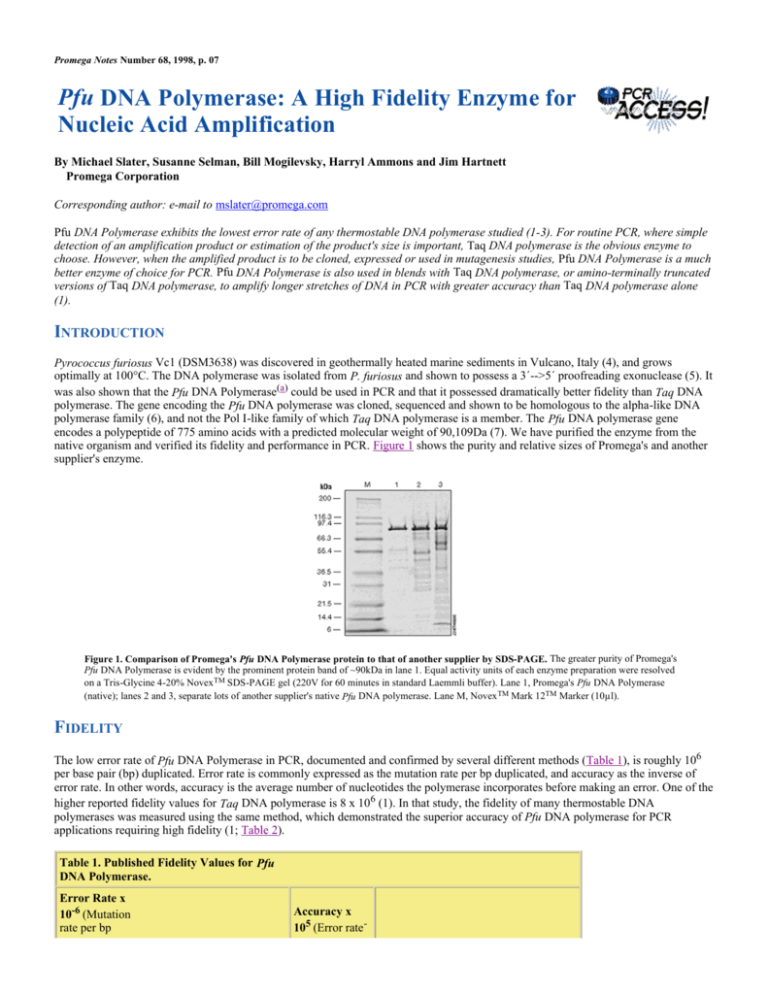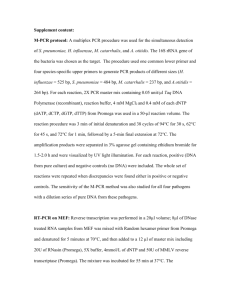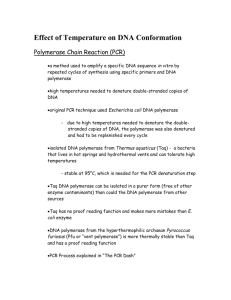
Promega Notes Number 68, 1998, p. 07
Pfu DNA Polymerase: A High Fidelity Enzyme for
Nucleic Acid Amplification
By Michael Slater, Susanne Selman, Bill Mogilevsky, Harryl Ammons and Jim Hartnett
Promega Corporation
Corresponding author: e-mail to mslater@promega.com
Pfu DNA Polymerase exhibits the lowest error rate of any thermostable DNA polymerase studied (1-3). For routine PCR, where simple
detection of an amplification product or estimation of the product's size is important, Taq DNA polymerase is the obvious enzyme to
choose. However, when the amplified product is to be cloned, expressed or used in mutagenesis studies, Pfu DNA Polymerase is a much
better enzyme of choice for PCR. Pfu DNA Polymerase is also used in blends with Taq DNA polymerase, or amino-terminally truncated
versions of Taq DNA polymerase, to amplify longer stretches of DNA in PCR with greater accuracy than Taq DNA polymerase alone
(1).
INTRODUCTION
Pyrococcus furiosus Vc1 (DSM3638) was discovered in geothermally heated marine sediments in Vulcano, Italy (4), and grows
optimally at 100°C. The DNA polymerase was isolated from P. furiosus and shown to possess a 3´-->5´ proofreading exonuclease (5). It
was also shown that the Pfu DNA Polymerase(a) could be used in PCR and that it possessed dramatically better fidelity than Taq DNA
polymerase. The gene encoding the Pfu DNA polymerase was cloned, sequenced and shown to be homologous to the alpha-like DNA
polymerase family (6), and not the Pol I-like family of which Taq DNA polymerase is a member. The Pfu DNA polymerase gene
encodes a polypeptide of 775 amino acids with a predicted molecular weight of 90,109Da (7). We have purified the enzyme from the
native organism and verified its fidelity and performance in PCR. Figure 1 shows the purity and relative sizes of Promega's and another
supplier's enzyme.
Figure 1. Comparison of Promega's Pfu DNA Polymerase protein to that of another supplier by SDS-PAGE. The greater purity of Promega's
Pfu DNA Polymerase is evident by the prominent protein band of ~90kDa in lane 1. Equal activity units of each enzyme preparation were resolved
on a Tris-Glycine 4-20% Novex TM SDS-PAGE gel (220V for 60 minutes in standard Laemmli buffer). Lane 1, Promega's Pfu DNA Polymerase
(native); lanes 2 and 3, separate lots of another supplier's native Pfu DNA polymerase. Lane M, Novex TM Mark 12TM Marker (10µl).
FIDELITY
The low error rate of Pfu DNA Polymerase in PCR, documented and confirmed by several different methods (Table 1), is roughly 106
per base pair (bp) duplicated. Error rate is commonly expressed as the mutation rate per bp duplicated, and accuracy as the inverse of
error rate. In other words, accuracy is the average number of nucleotides the polymerase incorporates before making an error. One of the
higher reported fidelity values for Taq DNA polymerase is 8 x 106 (1). In that study, the fidelity of many thermostable DNA
polymerases was measured using the same method, which demonstrated the superior accuracy of Pfu DNA polymerase for PCR
applications requiring high fidelity (1; Table 2).
Table 1. Published Fidelity Values for Pfu
DNA Polymerase.
Error Rate x
10-6 (Mutation
rate per bp
Accuracy x
105 (Error rate-
duplicated)
1)
Method
0.65 + 0.31
15
Direct measurement of PCR-generated
point mutant DNA by denaturing
constant capillary electrophoresis (2).
2.0
5
Measurement of p53 activity in yeast (S.
cerevisiae) after amplification and
transformation of the p53 gene (3).
7.7
Measurement of lacI activity in bacteria
(E. coli) after amplification and
transformation of the lacI gene (1).
1.3 + 0.2
Table 2. Reported Fidelity for Several Different Thermal Stable DNA Polymerases Using the
Forward Mutation Assay (1).
Error Rate x 10-6
Accuracy x 105
Pfu
1.3 + 0.2 S.D.
7.7
Deep VentR™
2.7 + 0.2 S.D.
3.7
Tli (VentR®)
2.8 + 0.9 S.D.
3.6
Taq
8.0 + 3.9 S.D.
1.3
55.3 + 2.0*
0.2
DNA Polymerase
UlTma®
*Range of duplicates.
We compared the fidelity of native Pfu DNA Polymerase from Promega with that of another supplier using a PCR-based forward
mutation assay of the E. coli lacI gene (Figure 2). The method is similar to that used by Cline et al. (1). Each PCR was prepared using
the supplied reaction buffer and according to the respective manufacturer's recommendations. Reactions were performed in duplicate as
described in Table 3. We found the accuracy of Promega's native Pfu DNA Polymerase to be 15 times greater than that of the other
supplier's native Pfu DNA polymerase. The increased accuracy of Promega's Pfu DNA Polymerase can be attributed to the difference in
the pH of the reaction buffers provided by each supplier, and is consistent with the data demonstrating the influence of pH on Pfu DNA
polymerase accuracy presented in Cline et al. (1).
Figure 2. Measurement of enzyme fidelity by a PCR-based forward mutation assay. Enzyme fidelity was measured by amplifying the lacIQ
gene and assessing its function in E. coli. A mutation introduced during PCR in the lacIQ gene will result in derepression of the lacZ gene and give a
blue colony phenotype on X-gal plates. While the lacIQ gene is 1,080 bases long, only 349 single-base substitutions in that region result in a mutant
phenotype (Cline et al. [1]). The first step in the forward mutation assay is amplification of a 1.8kb region containing the lacIQ gene and the
carboxy-terminus of the kan gene. Twenty cycles of PCR were performed using Pfu DNA polymerase, 200µM each dNTP and buffer containing
2.0mM Mg2+. One-tenth of the amplification product was subjected to electrophoresis on an agarose gel, and the expected 1.8kb PCR product was
quantified using a Molecular Dynamics FluorImager TM. The PCR amplification product was excised from the gel, purified with Wizard® PCR Preps
DNA Purification Resin (Cat.# A7170) and digested with Nco I and Nsi I. The Nco I-Nsi I fragment (1,776bp), also purified on Wizard ® PCR Preps,
was ligated into an Nco I-Nsi I digested 4.3 kb vector containing a carboxy-terminal truncated kan gene. Successful ligation of the PCR product to
the vector restores a functioning kan gene. Each construct in the resulting pool of ligation products contains either a wildtype or a mutant lacI Q gene.
The ratio of mutant and wildtype constructs varies with the accuracy of the DNA polymerase used in the amplification. The ligated mixture was
transformed into competent DH5alpha ® cells, and the transformed culture was plated on kanamycin/X-gal plates. The blue and white colonies were
counted to calculate the error rate as indicated. Error rate formula adapted from Lundberg et al. (5).
Table 3. Comparison of Fidelity for Promega's and Another Supplier's Native Pfu DNA
Polymerase*.
Supplier
Yield
lacI
Error Rate (x 10-6)
Accuracy (x 105)
Promega
5,166ng
0.36%
0.9
11
Other
5,431ng
0.40%
1.0
10
2,838ng
5.4%
15
0.67
2,875ng
5.6%
16
0.63
*Two
separate trials were performed per supplier. DNA Polymerases were tested in the supplier's
provided buffer. Two nanograms of template DNA were used per trial. Greater than 25,000 colonies were
scored for the LacI phenotype.
PERFORMANCE
The detection sensitivity of Promega's Pfu DNA Polymerase was compared with a leading supplier's native Pfu DNA polymerase in a
standard PCR protocol using decreasing amounts of human genomic DNA as template (Figure 3). The primers amplified a 1.2kb
fragment of the human alpha-1-antitrypsin gene. After 40 cycles, the amplified product could be visualized on agarose gel starting from
30pg of template DNA (equivalent to 10 copies of genomic DNA). Both enzyme preparations exhibited equivalent performance.
Figure 3. Comparison of amplification sensitivity of Promega's native Pfu DNA Polymerase to that of another supplier. A 1.2kb fragment of
the human alpha-1-antitrypsin gene was amplified using Promega's (Panel A) or another supplier's polymerase (Panel B). Promega's Pfu DNA
Polymerase was capable of amplifying 30pg of genomic template, the equivalent of 10 copies of this gene. After 40 cycles of amplification, 10µl
aliquots of the 50µl amplification reactions were analyzed on a 1% agarose gel followed by ethidium bromide staining. The amounts of Human
Genomic DNA (Cat.# G3041) template were: Lane 1, 30ng; lane 2, 3ng; lane 4, 300pg; lane 4, 30pg; and lane 5, no template. Lane M contains
Promega's 100bp DNA Ladder (Cat.# G2101).
In order to demonstrate the capability of Promega Pfu DNA Polymerase to amplify different templates, we performed PCR on DNA
isolated from mouse blood and tissues (Figure 4). Blood containing the anti-coagulants acid citrate dextrose (ACD), citrate, EDTA,
heparin and Alsever's solution, was used. DNA samples were isolated using a modified protocol for the Wizard® Genomic DNA
Purification Kit (see "Isolation and Analysis of Human Genomic DNA," which begins on page 20 of this issue, for more details on the
modified protocol).
Figure 4. Compatability of Promega's Pfu DNA Polymerase for amplification of DNA from varied sources. Amplification was performed on a
1,000bp fragment of mouse glyceraldehyde 3-phosphate dehydrogenase (G3PDH) gene using DNA isolated from mouse tissue and blood. DNA was
purified using the Wizard ® Genomic DNA Purification Kit protocol. Twenty nanograms of DNA was used as template in each amplification. Tissue
sources and blood anti-coagulants are indicated in the figure. Lane M contains 100bp DNA Ladder (Cat # G2101).
CLONING
Because Pfu DNA polymerase possesses proofreading activity, it does not have the terminal transferase-like activity demonstrated by
Taq DNA polymerase, which often places a nontemplate A residue at the 3´-end of amplimers (8). Pfu DNA Polymerase produces
blunt-ended amplification products (8). Purified, blunt-ended fragments may be modified by a second incubation with Taq DNA
polymerase, in the presence of dATP, to facilitate cloning into Promega's pGEM ®-T Easy Vector(b,c) (Figure 5). This cloning method
was tested using a 1,200bp fragment generated by amplification with Pfu DNA Polymerase. This procedure can generate 80-90%
positive transformants. Ligation reactions using nontailed amplified DNA resulted in no positive (white, recombinant) colonies.
Restriction digestion of selected recombinants with Not I verified the presence of the insert fragment (data not shown). We recommend
that the amplification reaction products be purified prior to modification to eliminate nonspecific reaction products, primers and primerdimers. Promega's Wizard® PCR Preps DNA Purification System (d) (Cat.# A7170) provides a convenient method for purifying
amplification products.
Figure 5. A-tailing protocol used to prepare a blunt-ended PCR product for T-vector cloning.
APPLICATION
Proofreading DNA polymerases such as Pfu have strong 3´-->5´ exonuclease activity, which can rapidly remove bases from the 3´ end
of PCR primers. Truncation of the oligonucleotides may result in an increase in the level of nonspecific amplification, as evidenced by
the presence of a smear on an agarose gel. This nonspecific amplification can be attributed to truncated primers annealing at undesirable
positions on the target DNA. When using Pfu DNA Polymerase, it is important to perform a hot start. Techniques such as withholding
the enzyme or magnesium until the tubes are placed in a thermal cycler, or assembling the reactions on ice and rapid transfer to a
preheated thermal cycler, can minimize this problem. Primers can also be protected by introducing phosphorothioate bonds at their 3´
termini (9).
SUMMARY
Promega is proud to offer native Pfu DNA Polymerase for high fidelity amplifications desired for cloning, mutagenesis, mutation
analysis and long PCR. Our Pfu DNA Polymerase was developed and manufactured under the quality standards of ISO 9001. The
quality controls performed on our Pfu DNA Polymerase include extensive assays for contaminating exonucleases, endonucleases,
general nucleases and the ability to amplify a 1.2kb DNA segment from 100 copies of a nonrepeated chromosomal target in genomic
DNA. The native enzyme provides exceptional accuracy and reproducible performance in high fidelity PCR.
REFERENCES
1.
2.
3.
4.
5.
6.
7.
8.
9.
Cline, J., Braman, J.C. and Hogrefe, H.H. (1996) Nucl. Acids Res. 24, 3546.
Andre, P. et al. (1997) Genome Res. 7, 843.
Flaman, J.M. et al. (1994) Nucl. Acids Res. 22, 3259.
Fiala, G. and Stetter, K.O. (1986) Arch. Microbiol. 145, 56.
Lundberg, K.S. et al. (1991) Gene 108, 1.
Mathur, E.J. et al. (1991) Nucl. Acids Res. 19, 6952.
Uemori, T. et al. (1993) Nucl. Acids Res. 21, 259.
Hu, G. (1993) DNA Cell Biol. 12, 763.
Skerra, A. (1992) Nucl. Acids Res. 20, 3551.
Ordering Information
Product
Pfu DNA Polymerase
Size
Cat.#
100 units
M7741
500 units
M7745
Pfu DNA Polymerase is supplied with 10X Reaction Buffer containing 20mM MgSO4.
Related Products
Product
Size
Cat.#
100 units
M1661
500 units
M1665
pGEM®-T Easy Vector, System I
20 reactions
A1360
pGEM®-T Easy Vector, System II
20 reactions
A1380
Taq DNA Polymerase
This system is provided with JM109 Competent Cells, High Efficiency.
(a)The
PCR process is covered by patents issued and applicable in certain countries. Promega does not encourage or support the unauthorized or unlicensed use of
the PCR process. Use of this product is recommended for persons that either have a license to perform PCR or are not required to obtain a license.
(b)U.S.
Pat. No. 4,766,072 has been issued to Promega Corporation for transcription vectors having two different bacteriophage RNA polymerase promoter
sequences separated by a series of unique restriction sites into which foreign DNA can be inserted.
(c)Licensed
under one or both of U.S. Pat. No. 5,487,993 and European Pat. No. 0 550 693.
(d)Licensed
under U.S. Pat. No. 5,075,430.
© 1998 Promega Corporation. All Rights Reserved.
pGEM and Wizard are trademarks of Promega Corporation and are registered with the U.S. Patent and Trademark Office.
DH5alpha is a registered trademark of Life Technologies, Inc. FluorImager is a trademark of Molecular Dynamics, Mark 12 and Novex
are registered trademarks of Novel Experimental Technology. UlTma is a registered trademark of Perkin-Elmer.
Deep VentR is a trademark of, and VentR is a registered trademark of New England BioLabs.
Product claims are subject to change. Please contact Promega Technical Services or access the Promega online catalog for the most
up-to-date information on Promega products.








